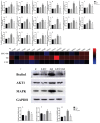Antagonistic effects of lycopene on cadmium-induced hippocampal dysfunctions in autophagy, calcium homeostatis and redox
- PMID: 28615536
- PMCID: PMC5546513
- DOI: 10.18632/oncotarget.18249
Antagonistic effects of lycopene on cadmium-induced hippocampal dysfunctions in autophagy, calcium homeostatis and redox
Abstract
Cadmium (Cd), a widely existed environmental contaminant, was shown to trigger neurotoxicity by regulating autophagy, ion homeostasis and redox. Lycopene (LYC) is a natural substance with potent antioxidant capacity. Nevertheless, little is known about i) the relationship of Cd-induced neurotoxicity and autophagy, ion homeostasis as well as redox in the hippocampus; ii) the role of LYC in the regulation of hippocampal autophagy, ionic balance and antioxidant capacity during Cd exposure. Therefore, this study sought to investigate the Cd exposure-induced hippocampal dysfunctions for neurotoxicity, and the preventive potential of LYC on the hippocampus impairment by reversing the dysfunctions during the exposure. In vivo study with mice model demonstrated that Cd exposure increased gene expression of a wide spectrum of autophagy-related gene (ATG) and gene regulating autophagy in hippocampus. This suggests the activation of hippocampal autophagy mediated by Cd. Cd exposure also decreased Ca2+-ATPase activity, thus increasing intracellular Ca2+ concentration in hippocampus, indicating the possibility that Cd-induced autophagy requires the Ca2+ signaling. Moreover, Cd exposure triggered redox stress in hippocampus cells, as antioxidant enzyme activities were decreased while oxidative productions were promoted. Cd exposure led to severe cytotoxicity in hippocampus cells. Of important note, all the hippocampal dysfunctions upon Cd exposure were reversed by LYC treatment to normal situations, and exposure-induced neurotoxicity was abrogated. The in vivo findings were recapitulated relevantly in the mouse hippocampal neuronal cell line, TH22. In all, the above data imply that LYC could be a potent therapeutic agent in treating Cd-triggered hippocampal dysfunctions and subsequent cell damage.
Keywords: autophagy; cadmium; ion-ATPases; lycopene; redox.
Conflict of interest statement
The authors disclose no conflicts of interest.
Figures







Similar articles
-
Supplementation of lycopene attenuates oxidative stress induced neuroinflammation and cognitive impairment via Nrf2/NF-κB transcriptional pathway.Food Chem Toxicol. 2017 Nov;109(Pt 1):505-516. doi: 10.1016/j.fct.2017.09.050. Epub 2017 Sep 30. Food Chem Toxicol. 2017. PMID: 28974442
-
Lycopene attenuates aluminum-induced hippocampal lesions by inhibiting oxidative stress-mediated inflammation and apoptosis in the rat.J Inorg Biochem. 2019 Apr;193:143-151. doi: 10.1016/j.jinorgbio.2019.01.017. Epub 2019 Feb 1. J Inorg Biochem. 2019. PMID: 30743053
-
Lycopene protects against trimethyltin-induced neurotoxicity in primary cultured rat hippocampal neurons by inhibiting the mitochondrial apoptotic pathway.Neurochem Int. 2011 Dec;59(8):1095-103. doi: 10.1016/j.neuint.2011.10.005. Epub 2011 Oct 19. Neurochem Int. 2011. PMID: 22032970
-
Calcium homeostasis disruption - a bridge connecting cadmium-induced apoptosis, autophagy and tumorigenesis.Oncol Res Treat. 2015;38(6):311-5. doi: 10.1159/000431032. Epub 2015 May 19. Oncol Res Treat. 2015. PMID: 26045029 Review.
-
A review for the pharmacological effect of lycopene in central nervous system disorders.Biomed Pharmacother. 2019 Mar;111:791-801. doi: 10.1016/j.biopha.2018.12.151. Epub 2019 Jan 4. Biomed Pharmacother. 2019. PMID: 30616078 Review.
Cited by
-
Nutraceuticals as Modulators of Autophagy: Relevance in Parkinson's Disease.Int J Mol Sci. 2022 Mar 26;23(7):3625. doi: 10.3390/ijms23073625. Int J Mol Sci. 2022. PMID: 35408992 Free PMC article. Review.
-
Influenza M2 protein regulates MAVS-mediated signaling pathway through interacting with MAVS and increasing ROS production.Autophagy. 2019 Jul;15(7):1163-1181. doi: 10.1080/15548627.2019.1580089. Epub 2019 Feb 20. Autophagy. 2019. PMID: 30741586 Free PMC article.
-
Adolescent cadmium exposure impairs cognition and hippocampal neurogenesis in C57BL/6 mice.Environ Toxicol. 2022 Feb;37(2):335-348. doi: 10.1002/tox.23402. Epub 2021 Nov 6. Environ Toxicol. 2022. PMID: 34741586 Free PMC article.
-
The Remedial Potential of Lycopene in Pancreatitis through Regulation of Autophagy.Int J Mol Sci. 2020 Aug 12;21(16):5775. doi: 10.3390/ijms21165775. Int J Mol Sci. 2020. PMID: 32806545 Free PMC article. Review.
-
Neuroprotective Impact of Linagliptin against Cadmium-Induced Cognitive Impairment and Neuropathological Aberrations: Targeting SIRT1/Nrf2 Axis, Apoptosis, and Autophagy.Pharmaceuticals (Basel). 2023 Jul 27;16(8):1065. doi: 10.3390/ph16081065. Pharmaceuticals (Basel). 2023. PMID: 37630980 Free PMC article.
References
MeSH terms
Substances
LinkOut - more resources
Full Text Sources
Other Literature Sources
Miscellaneous

